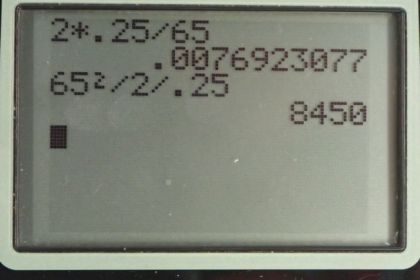Question
A fireworks shell is accelerated from rest to a velocity of 65.0 m/s over a distance of 0.250 m. (a) How long did the acceleration last? (b) Calculate the acceleration.
Final Answer
Solution video
OpenStax College Physics, Chapter 2, Problem 30 (Problems & Exercises)

vote with a rating of
votes with an average rating of
.
Calculator Screenshots
Video Transcript
This is College Physics Answers with Shaun Dychko. A firework shell is launched starting at rest and so the initial velocity is zero and it reaches a final velocity of 65 meters per second and this acceleration occurs over a distance of 0.250 meters so we'll take that to be the final position and that means x naught is zero for the initial position. So we have written down all the things that we know. In part (a), we are asked to figure out over what time is this firework shell accelerated? So we are choosing this formula number 50 in chapter 2 because it contains all things that we know and then the one thing that we don't know that we can calculate. So we know average velocity because we can use equation 51 to find it by taking the initial velocity plus the final velocity and dividing by 2 and then we substitute that into our formula for position in this line here and I have shown in red the replacement of v bar with this formula. Now we can simplify things by noticing that x naught is 0 and v naught also is 0 and so getting rid of those terms, we can rewrite this as x equals, the final position equals, the final velocity times time divided by 2 and then we'll rearrange this to solve for t by multiplying both sides by 2 over final velocity and then the 2's cancel and the v's cancel on the right and then on the left we have 2x over v and then we have also switched the sides around so that the unknown t is on the left so t is 2 times the final position divided by the final velocity. So that's 2 times 0.250 meters divided by 65 meters per second and this is 7.69 milliseconds or you could write 7.69 times 10 to the minus 3 seconds. In part (b), we are asked to figure out the acceleration. Now we could choose a formula like this, x equals x naught plus v naught t plus one-half at squared— that's equation [2.53]— but I discourage this because it's using a number that we have calculated before and there's a possibility that you have made a mistake with this calculation and if that's so then this also would result in a mistake. So there's nothing technically wrong with using this formula; the formula is great and it would work very nicely if you solve it for a but there's that certain risk of using a number that you have calculated and so there's a preference then for this formula here, this is number 54, which contains raw data that we are given so it uses only these numbers that we have started with and there's no mistake there because that's copied directly from the question and so let's solve this for a. And first we'll simplify it by getting rid of the terms that are zero so the initial velocity is zero and the initial position is zero so this simplifies to v squared equals 2ax and we'll solve this for a by dividing both sides by 2x and switching the sides around. So acceleration is final velocity squared divided by 2 times final position. So that's 65 meters per seconds squared divided by 2 times 0.250 meters giving 8.45 times 10 to the 3 meters per second squared is the acceleration.
